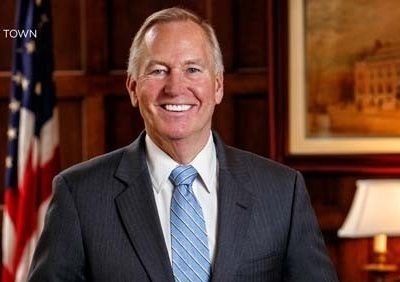All roads lead to the center of New Jersey, where the newly cosmopolitan seat of Middlesex County government pulsates with the excitement of rejuvenation
by Laura D.C. Kolnoski • Photos By Amessé Photography
James M. Cahill revels in being mayor of New Brunswick. The feeling must be mutual because his constituents have returned him to office seven times. Cahill has served as mayor of “Hub City,” his first elected office, since 1991.
Once a symbol of urban decay, Cahill’s New Brunswick has experienced an enviable level of investment, growth and resurgence. Much of that has evolved from private-sector collaborations with esteemed local institutions such as Rutgers University, Johnson & Johnson, Robert Wood Johnson University Hospital, Saint Peter’s University Hospital, the University of Medicine and Dentistry of New Jersey, Bristol-Myers Squibb, and Children’s Specialized Hospital.
The city’s redevelopment partner, the New Brunswick Development Corporation (DEVCO), helped propel this renaissance. More than $2.5 billion has been invested in the construction of residential, retail, office, educational, health-care and arts facilities, generating more than $21.5 million in annual revenue. More than 6,500 jobs have been created over the past 10 years in New Brunswick, resulting in an unemployment rate of 3.7 percent; far better than the overall New Jersey unemployment figure of 5.1 percent reported in January.
“We’re now a revitalized city renowned for its institutions and health-care facilities,” said Cahill, a lifelong New Brunswick resident. “We work together through shared goals and have achieved great strides through collaboration.”
That work is facilitated by the mayor’s deep knowledge of his hometown. Educated at St. Peter’s High School, Cahill earned an Associate degree from Middlesex County College. As a young adult, baseball was a passion; he played catcher on his high school and college teams and later in semi-pro leagues. Cahill said he entered government to “fill gaps not addressed” and worked to develop an understanding of public and civil service. Parents Helen and Jim were cited as mentors.
Cahill later earned a Bachelor of Science in Law Justice from Glassboro State College (now Rowan University), and a master’s degree in Criminal Justice from Rutgers. He obtained his Juris Doctorate from Seton Hall University School of Law and is a partner in the firm Cahill, Branciforte & Hoebich in New Brunswick. In 1980, he was named assistant city attorney, a post he held until being elected mayor.
“Many my age were influenced by the politics and aspirations of the John F. Kennedy era; that government could make a change in people’s lives,” he said. “It’s great to be able to have a direct influence on the direction our community takes in the place you lived your entire life, working with others who have the same passion for the town and creating a place people want to be. It has been a positive and rewarding experience and at times very challenging, too.”
In a diverse community, Cahill has worked to form relationships in every neighborhood. The city, he said, has maintained an open and honest government that has achieved steady progress in a number of areas. All city employees, the mayor added, are told they have a common mission: public service.
“I learned early on most of us agree on the same basic things and reasonable discussion can help us keep moving forward,” the mayor said. “There aren’t many surprises on what folks’ perspectives will be. People know the type of person I am—committed, passionate and dedicated to improving the quality of life for all.”
Cahill said he and the City Council strive never to lose sight of what the government’s basic responsibilities are, whether it’s bringing major projects to fruition or helping residents frustrated with smaller quality of life issues such as trash pickup.
Of course, having New Jersey’s state university in New Brunswick provides a host of benefits for the city, Cahill said.
“Rutgers is a very positive influence, adding a great deal of vitality and youthful energy to New Brunswick,” he said. “Both entities serve as think tanks for each other, from research to resolutions to issues. The city serves as a working laboratory, giving students and staff real-life experiences.”
Not including the seasonal influx of Rutgers’ students and faculty, New Brunswick’s population is approximately 57,000. During the work week, that number doubles.
“The relationship with Rutgers has gotten better with time and bodes well for the future,” added the mayor. “A lot of students gain a fondness for New Brunswick and become residents, adding to the character of the city.” Some of those new residents are enjoying three new modern luxury high-rise apartment buildings with retail components that opened during the last five years: The Aspire, The Vue and The George.
Cahill said the Rutgers population also supports the city’s hospitality industry, which begins with its theaters and is bolstered by a bustling downtown filled with popular restaurants and taverns, making New Brunswick a growing foodie destination. Patrons from the tri-state area already flock to shows at the George Street Playhouse, the State Theater, Crossroads Theatre and the American Repertory Ballet.
“The arts are the heart and soul of a community,” Cahill said. “It’s an economic driver with a return on investment that has helped propel the city. The growth of the theater district and college has paralleled each other. There is no shortage of places to eat. Newer ones create excitement, while others continue to provide the highest quality. There is a whole new world on French Street with Latino cuisine. If you are hungry, just come to New Brunswick. You won’t be disappointed.”
Warm weather brings outdoor carnivals, festivals and musical events; some taking advantage of the city’s location on the Raritan River. The park system oversees 272 acres of playgrounds, passive areas, athletic fields, facilities, lawns and gardens. The award-winning Elmer B. Boyd Park (named after the publisher of the New Brunswick Home News), with 20 acres along the river, a floating dock, and 24 slips for boaters underwent an $11 million rehabilitation in the late 1990s.
Quality of Life
Education has been a particular focus for Cahill, who helped create an innovative neighborhood strategy with the new Lord Stirling Community School, now seen as a model for new school construction. The new $185 million New Brunswick High School opened in 2010. Small Learning Communities at that facility provide in-depth career exploration and training in science, technology, engineering, and mathematics as well as fine, visual, and performing arts. Cahill received a Community Leadership Award in 2006 for his strong support of after-school programs. Earlier this year, doors opened at the new 101,000 square-foot Redshaw Elementary School. Funding has also been secured for a 60,000 square-foot addition to the Paul Robeson Community School, along with other renovations.
New Brunswick has taken a lead role in the urban wellness movement, working on initiatives with community partners including Healthier New Brunswick, Live Well-Vivir Bien New Brunswick, the New Brunswick Community Food Alliance, New Brunswick Ciclovia, Breakfast After the Bell, and the Community Farmers Market. The city established a Complete Streets policy in 2012 to make the city safer and more accessible for cyclists, pedestrians, and motorists. Miles of bike lanes and “sharrows” (shared lane markings) and new bicycle corrals, which provide safer travel routes, have been installed. Pedestrian improvements include the installation of flashing crosswalks, curb extensions on busy neighborhood streets and pylons to increase visibility at street corners.
The Next Big Thing
Replacing the vacant Ferren Mall and parking deck, a new city jewel is poised to rise adjacent to the New Brunswick train station. Called The Hub @ New Brunswick Station, the development calls for 1.7 million square feet of office space, residential units, parking, retail, nightlife, and open public space on four acres.
Conceptual designs showing the Hub’s two gleaming towers and plaza space were created to help demonstrate its potential to developers and occupants. A new performance center is a centerpiece of the plan, with the George Street Playhouse, State Theatre, and ballet all slated to relocate there.
“This will be a great point of entry and a portal for us; a gateway to the rest of New Brunswick,” Cahill said, adding that DEVCO is spearheading the project. “The mixed-use component will help drive economics and deliver revenue to reinvest in the arts.”
Plans also allow for offices for the arts organizations, along with rehearsal space, costume and storage rooms, and scenery facilities, topped by 250-300 residential units.
An environmental cleanup is underway at the site, to be followed by demolition. Once a symbol of the city’s early revitalization efforts, the now-closed parking garage was not sufficiently utilized, the mayor said.
The project architect is Kohn Pedersen Fox Associates of New York.
Cahill and his wife Laura are parents to son Casey, daughter in-law Lindsay, daughter Rebecca, son in-law Michael and grandsons Colton and Harrison. Past president of the New Brunswick Bar Association, he is also a member of the New Jersey Bar Association and the Middlesex County Bar Association. He formerly served on the New Jersey Supreme Court District Ethics Committee and the New Jersey Supreme Court Committee on the Tax Court.







